History > QUESTIONS & ANSWERS > HIEU 201 Chapter 1 quiz Western Civilization 1 Completed A 2022/2023 (All)
HIEU 201 Chapter 1 quiz Western Civilization 1 Completed A 2022/2023
Document Content and Description Below
HIEU 201 Chapter 1 quiz Western Civilization 1 Chapter 1 quiz Western Civilization 1.Paleolithic religious beliefs a. did not include belief in life after death. b. made a clear distinction betwee... n nature and the supernatural. c. centered around the idea that human beings needed to appease the forces of nature. d. centered around the idea that forces of nature had been created to serve human beings. 2.Which of the following is NOT a feature of the Neolithic Age? a. Human beings domesticated animals. b. Human beings established villages. c. Human beings discovered farming. d. Human beings started using iron tools. 3.The first civilizations a. abandoned the monumental architecture of prehistoric cultures. b. did not yet possess specialization of labor. c. developed systems for administration, cooperation, and record-keeping. d. lacked organized governments. 4. Sargon the Great a. conquered territories, plundered their resources, and then left to find new opportunities for conquest. b. contributed to the spread of Sumerian culture beyond the boundaries of Mesopotamia. c. was known for his policy of pursuing peace at any cost. d. was the leader of an important Sumerian city-state. 5.The Sumerians erected their religious temples atop huge multilevel mounds calleda. cuneiform. b. ziggurats. c. Nammu. d. stele. 6.The kings in ancient Mesopotamia a. were viewed as being above the law and absolute in their power. b. were believed to be living gods. c. were rulers thought to have been selected by the gods to represent them on earth. d. were replaced by democracies governed by elders and assemblies of citizens. 7.The economy of Mesopotamian cities a. was conducted by a state bureaucracy. b. was entirely self-sufficient. c. depended heavily on foreign and domestic trade. d. was largely unregulated. 8.Which of the following describes the Egyptians' relationship with their environment? a. The challenges of nature were designed to punish human beings. b. The lack of natural boundaries subjected Egyptians to constant invasion and change. c. The unpredictability of the Nile made Egyptian life precarious. d. Nature served as a source of security. 9.The pharaohs a. technically owned no earthly possessions. b. had little impact on the lives of peasants and workers. c. communicated the gods' will to the Egyptian people. d. were elected by a noble class.10.The Hittites a. were absorbed into Babylonian civilization. b. rejected all aspects of foreign culture. c. achieved no substantial technological progression. d. ruled Asia Minor and northern Syria. 11.Which of the following is NOT true of the Persian empire? a. It allowed local elites a large measure of self-rule. b. It developed an effective administrative system of twenty provinces. c. It was bound together by a uniform language, Aramaic. d. It was ruled by a council thought to represent the people. 12. Compared to a rational or scientific view of the world, a mythopoeic view a. sees the world of nature as an entity, like a machine, rather than a living being. b. is more logically consistent than the rational view developed by the Greeks. c. shows little imagination or emotion in interpreting nature. d. appeals primarily to the emotions rather than reason and tends to be more subjective than objective. 13.The ________ Age is also known as the Old Stone Age. a. Classical b. Archaic c. Paleolithic d. Neolithic Which of the following civilizations rose first? a. Phoenician b. Sumerianc. Hittite d. Assyrian The Epic of Gligamesh depicts the Mesopotamians' mood of a. optimism and hope. b. sensuality and emotionality. c. pessimism and despair. d. stoicism and tranquility. In Paleolithic societies, human beings a. obtained the necessities of life by gathering food and hunting. b. lived in large permanent settlements of several thousand people. c. were unable to communicate with one another by language. d. had not yet acquired the ability to make tools. The central force in the first civilizations was a. popularly-selected governance. b. religion. c. iron technology. d. science. In Hammurabi's code of law a. crimes against nobles were punished more severely than crimes against commoners. Correct b. the king was not bound by the law, but might legally do whatever he wished to do. c. women enjoyed a legal status equal to that of men.d. women and children had no legal protection. The religious teachings of the prophet Zoroaster a. are a complex set of polytheistic beliefs based on magic and blood sacrifice. b. reject the need for ethics in human life. c. are dualistic, asserting the existence of both a good god and an evil god. d. represent the earliest known examples of monotheistic faith. The Egyptian New Kingdom began with the war of liberation against the a. Nubians. b. Assyrians. c. Hyksos. d. Babylonians. Chapter 2 quiz The biblical account of the Exodus identifies ________ as leading the Hebrews out of Egypt. a. Saul b. Moses c. David d. Abraham Under the rule of David's son Solomon, a. old tribal patterns gained renewed strength. b. Israel reached the height of its power and prosperity. c. the Israelites lost Jerusalem to the Philistines. d. Jerusalem decreased in importance.Hide Feedback The Old Testament a. explores only human weakness and cruelty. b. is a record of ancient Jewish history compiled by research historians. c. depicts demigods as its heroes. d. describes the efforts of the Jews to understand the ways of God. The Hebrews thought of Yahweh as a. fully powerful and therefore fully free. b. a superhuman deity who required food, drink, sleep, and sexual gratification. c. a universal spirit that resided in the elements of nature, such as the earth, the moon, and the sun. d. the great creator of the universe, who had then withdrawn entirely from earthly affairs. Which of the following describes the Hebrews' relationship with the natural world? a. Natural phenomena were the result of God's handiwork. b. The Hebrews demystified nature by creating theoretical science. c. God was a part of nature and was thus affected by numerous natural forces like storms. d. Nature was divine, and natural phenomena were invested with supernatural qualities. In the history of the Hebrew people, the covenant has served to a. emphasize the all-importance of the Hebrew nation over all other people.b. encourage the Hebrews to turn inward and take a very limited role in human affairs. c. justify the exploitation and oppression of the weakest members of society. d. emphasize the unique relationship of God to the Israelites as a chosen people that had accepted God's moral code. The historical significance of Israelite law was that it a. introduced the idea of private property as the most important concept in society. b. rejected protection of the widows, orphans, and slaves. c. embraced the idea that law should treat people differently depending on their wealth. d. demonstrated greater ethical awareness than other legal codes of the Near East. The Hebrews regarded history as a. the random result of human acts. b. a purely secular subject. c. a great cycle, with the same events occurring over and over again. d. a process leading to a goal. During the flowering of the prophetic movement, the Hebrew prophets a. embraced parochialism and believed Israel's sacred mission was to focus on the chosen people alone. b. preached social responsibility and criticized those who emphasized accumulation of possessions and wealth. c. saw poverty and injustice as facts of life that would be futile to oppose. d. insisted that Yahweh would be pleased only by the observance of proper rituals and ceremonies. All of the following is true of universalism in Hebrew thought EXCEPT a. its stress on the special nature and destiny of the Hebrews as God's chosen people. b. its emphasis that Israel was charged to lead in the struggle against idolatry.c. its contradiction of the narrow, tribal origins of Hebrew society. d. its concern for all humanity. Hide Feedback The first five books of the Old Testament are known as the a. Quintarch. b. Talmud. c. Torah. d. Tanak. The Hebrews originated in a. Canaan. b. Egypt. c. Mesopotamia. d. Palestine. During the eleventh century B.C., the leadership of Saul united the ________ Hebrew tribes in Canaan. a. twenty b. twelve c. two d. ten After the fall of Israel to the Assyrians in 722 B.C. a. thousands of Hebrews were exiled to Syria. b. the prophets Isaiah, Ezekiel, and Jeremiah declared that the Hebrews had been forsaken by Yahweh. c. the Hebrews experienced an immediate return to their former power. d. many Hebrews lost their identity as the people of God. The Hebrews' concept of Yahweha. is similar to that of other ancient monotheisms, such as the worship of Aton in Egypt. b. shows that they were monotheists from their earliest days in Mesopotamia. c. emphasizes the God's power as ruler of all and subject to none. d. views Yahweh as one of many gods, all deserving honor and obedience by humans. Which of the following is a fundamental Hebrew belief about the individual? a. God did not create people to be his slaves. b. Human beings ranked equally with all other elements of God's creation. c. God desired his people to grovel before him and forbid them the capacity to take responsibility for their conduct. d. Human beings lacked the power to choose between righteousness and wickedness. . The Hebrews' belief in moral responsibility resulted from a. an awareness of individual human beings as having free will to act. b. pride in oneself. c. communal traditions. d. an emphasis on the family as the source of morality. The Old Testament discussed slaves a. as deserving no protection. b. as the absolute property of the slave-owner, to do with as he wished. c. in the same way as all other ancient Near Eastern law. d. as human beings deserving justice and moral treatment. Under Hebrew law, within the family a. a divorce could be granted by request of either the husband or wife. b. women were treated as property. c. women had full legal rights.d. the father had supreme authority. The legacy of the ancient Jews includes all of the following EXCEPT a. the value Westerners place on the individual. b. monotheism. c. a fundamental component of Christianity. d. the idea that all time is cyclical. Chapter 3 starts with 6 Solon's reforms a. opened the highest offices to the poorest Athenians. b. excluded the poor from political participation. c. excluded aristocrats from political life. d. undermined the rights of the traditional aristocracy. The Persians attacked Greece in the fifth century B.C. because a. they wished to add the riches of Greece to their empire. b. they wanted to crush the Athenian democracy before its ideas spread to peoples in the Persian Empire. c. Athens had aided a revolt by the Ionians, and the Persians wished to punish them for their interference. d. Sparta and the Peloponnesian League were threatening to invade Asia Minor, which borders on Persia. The Athenian navy delivered a decisive Greek victory against the Persians in 480 B.C. at a. Plataea. b. Marathon. c. Thermopylae. d. Salamis.Pericles was a. a Spartan who admired Athenian democracy. b. a military leader who was credited with saving Athens during the Persian Wars. c. the leading figure in Athenian political life during the middle of the fifth century B.C. d. a tyrant who rejected Athenian democracy. According to Demosthenes a. the Greeks faced decline if they did not show contrition to the gods. b. the Greeks faced decline if they did not unite against their common enemy, Macedonia. c. the Greeks faced decline because their enemies loved freedom more than they did. d. Athens faced decline if it pursued too much cooperation with other city-states rather than pursue its own particular interests. Artifacts and archaeological evidence of the Minoans on Crete indicate a. magnificent fortified palaces with extensive defensive structures that served as political centers. b. a warlike culture that rejected artistic and cultural pursuits. c. a civilization that did not predate that of the Mycenaeans. d. a substantial export trade from Crete to Egypt, Syria, Asia Minor, and Greece. Which of the following is NOT a feature of Mycenaean civilization? a. It reached its height in the period from 1400 to 1230 B.C. b. It owed a considerable debt to Minoan civilization on Crete. c. It had a political system that can be seen as an early form of democracy. d. It disintegrated due to constant warfare between its various kingdoms. The earliest examples of the polis a. united all Greeks under the rule of a divine kingship. b. were small city-states based on tribal allegiances.c. were confederations of city-states acting in harmony in both war and peace. d. evolved from rational origins to theocracy. The mature polis was a a. self-governing community that expressed the will of free citizens. b. community in which laws were seen as deriving from divine rulers. c. community designed to express the will of the gods. d. community in which religion played no role whatsoever. In contrast to Sparta a. Athens defined freedom as the independence of the fatherland. b. Athens was a land power and exclusively agricultural. c. Athens possessed no navy. d. Athens valued the political freedom of the individual. By Dik, Solon meant a. the obligation of all Athenians to take part in the defense of their city. b. personal excellence in warfare. c. the principle of justice that is that underlies all human community. d. the arrogance of the tyrants he opposed. The Delian League a. was created by rivals to Athens within the Peloponnesian League. b. was an alliance of city-states dominated by the largest polis, Athens. c. was an instrument of Spartan economic expansion. d. grew primarily because states voluntarily placed themselves under the protection of Athenian military power. The mature democracy that evolved in Athens by the fifth century B.C.a. granted political power to an Assembly made up of all adult male citizens. b. prevented the emergence of strong political leaders who could influence the policies of the state. c. chose all offices, even the most critical, by luck of the draw. d. ensured the political equality of all people in the polis. Athenian women were a. able to hold office but could not vote. b. considered the equals of their husbands. c. often highly educated. d. considered the wards of their husbands. As a result of the Peloponnesian War a. Athens eliminated its enemies and ended all attacks on Greek city-states. b. Sparta destroyed the city of Athens and executed its leader, Pericles. c. Athens brought democracy to Sparta by utilizing the resources of Syracuse. d. Athens experienced a decline in the quality of its leadership. [Show More]
Last updated: 1 year ago
Preview 1 out of 13 pages
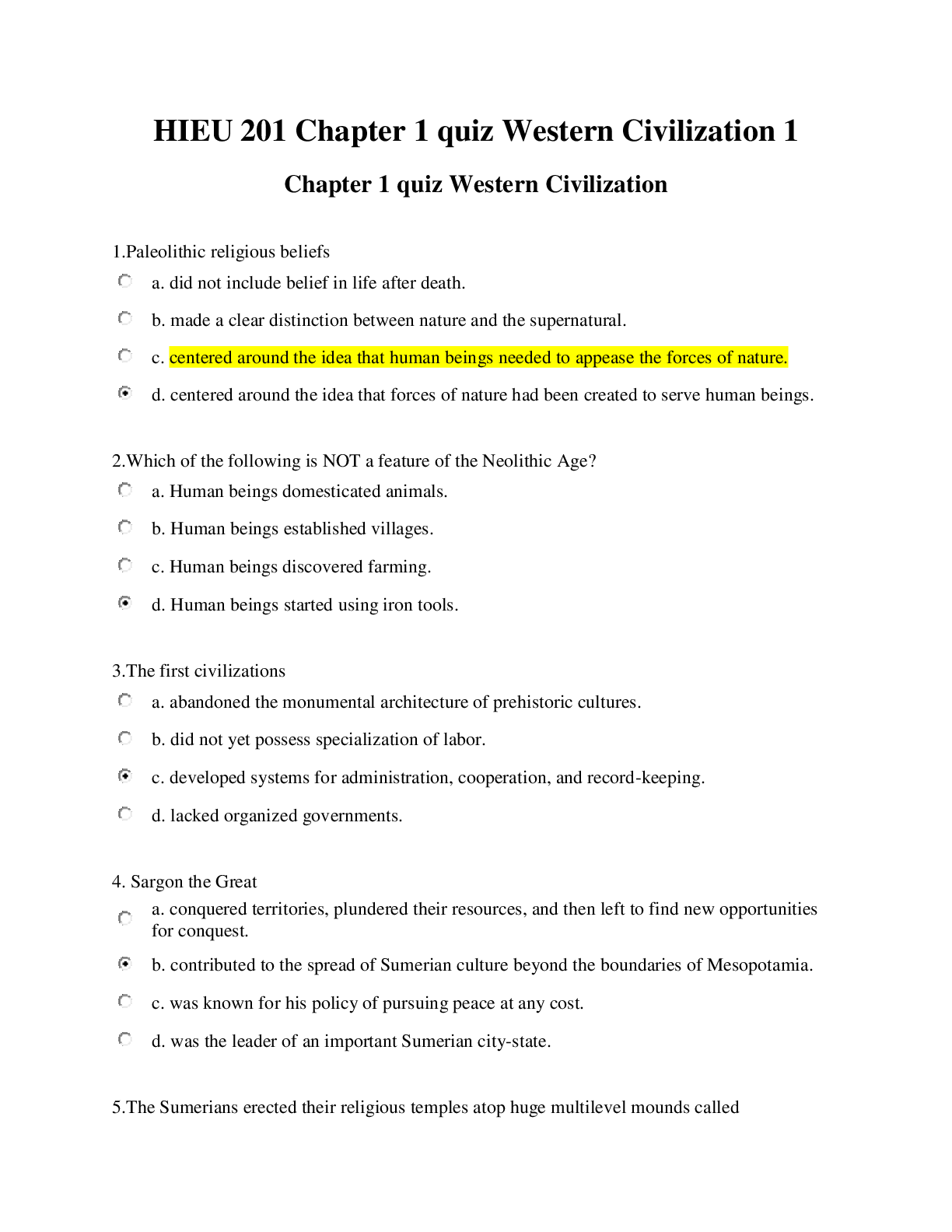
Reviews( 0 )
Document information
Connected school, study & course
About the document
Uploaded On
Mar 16, 2021
Number of pages
13
Written in
Additional information
This document has been written for:
Uploaded
Mar 16, 2021
Downloads
0
Views
66

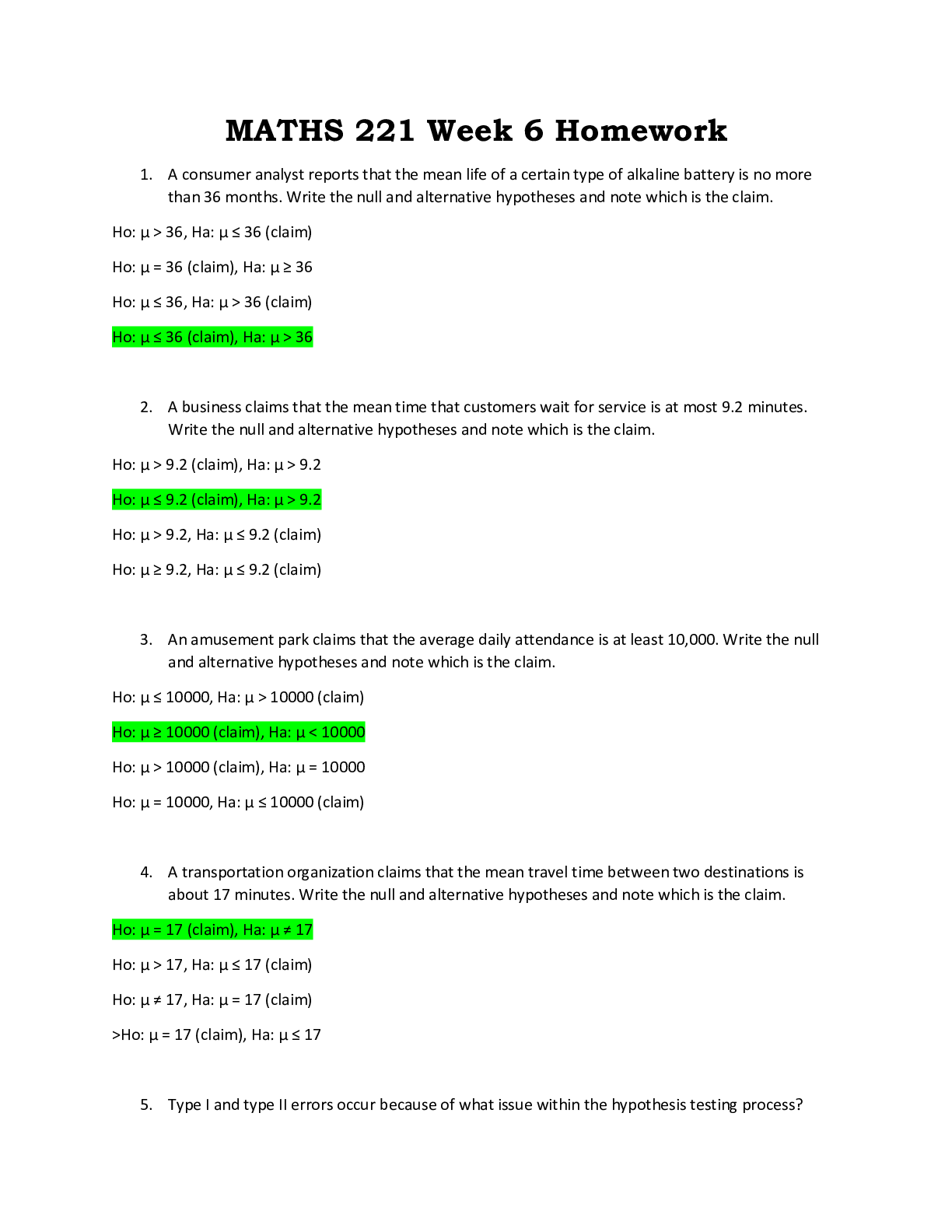
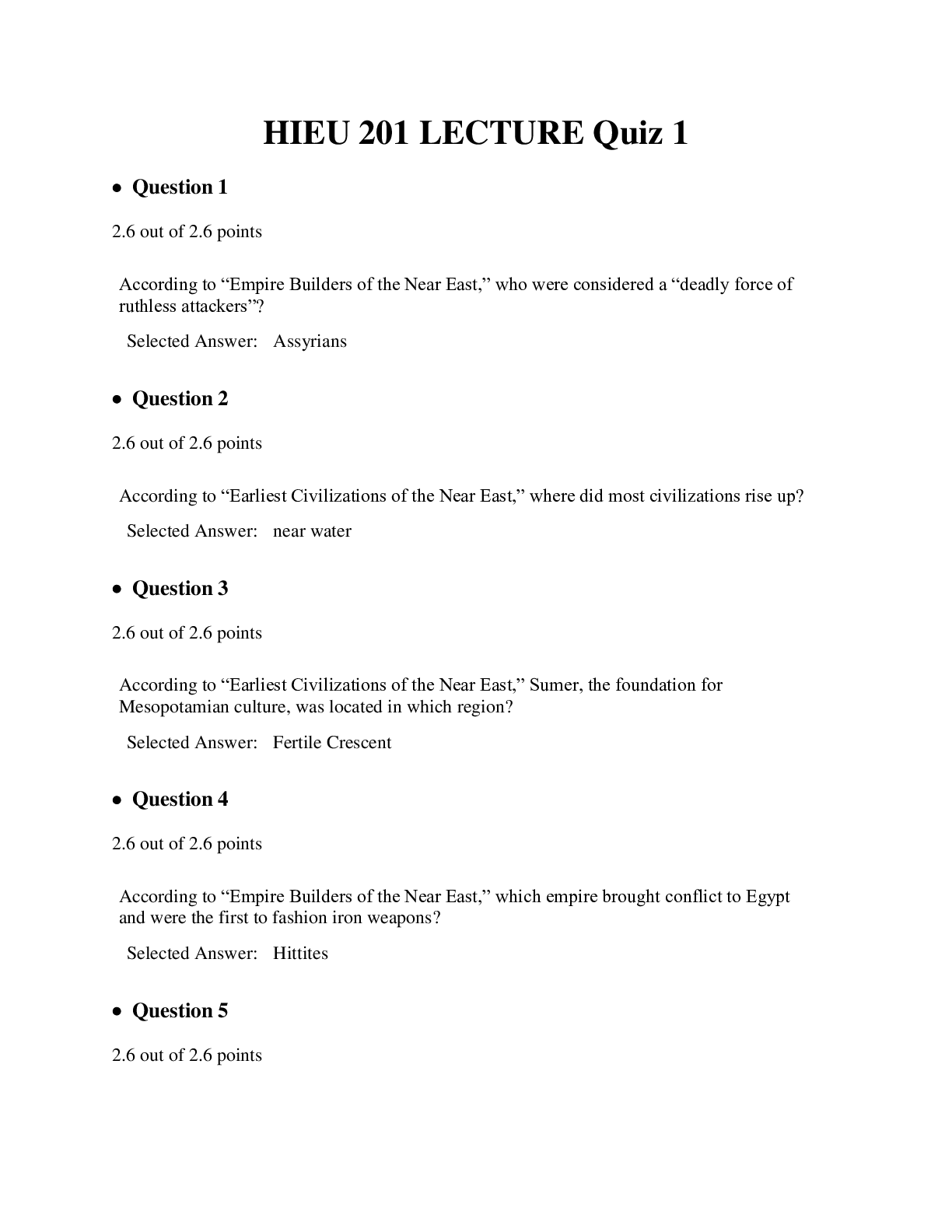
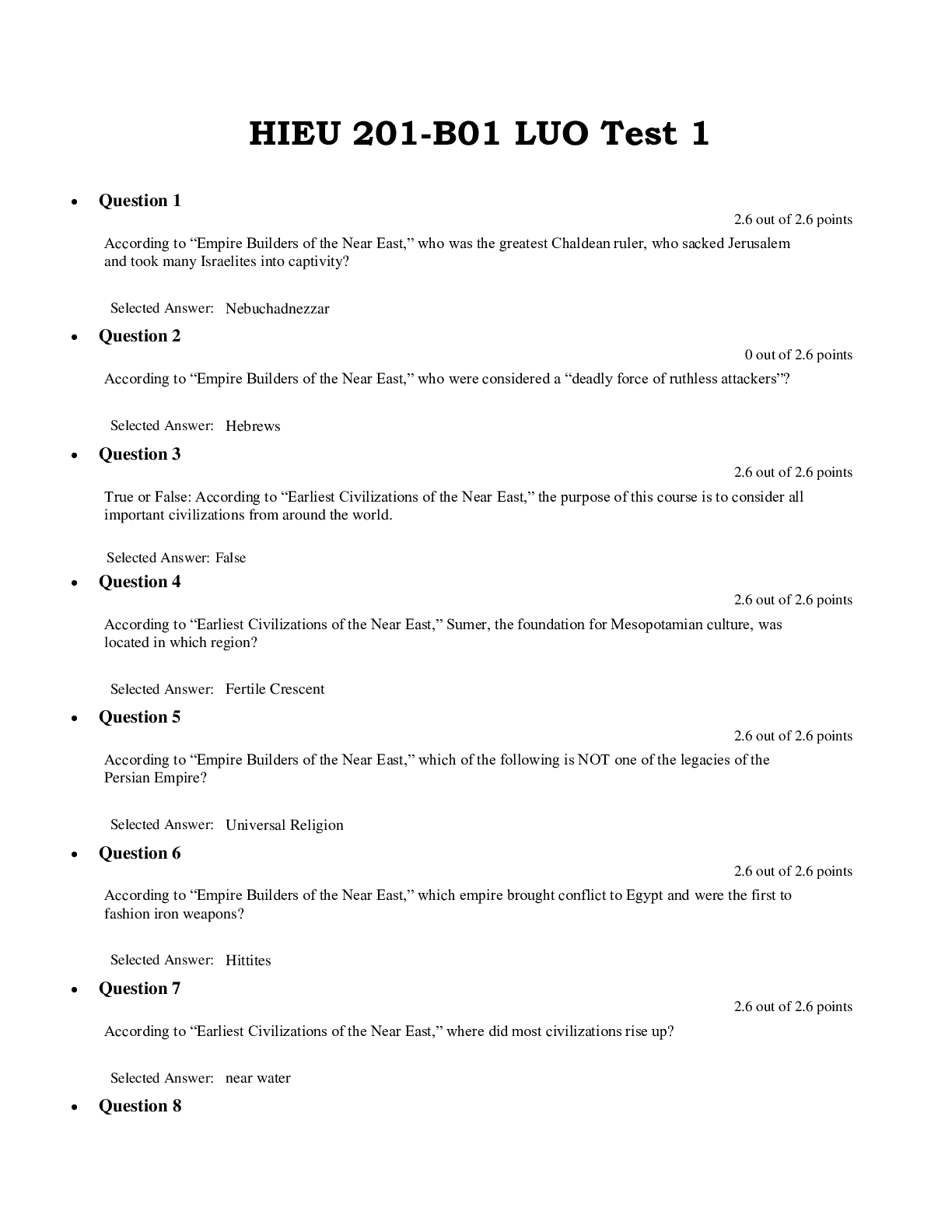
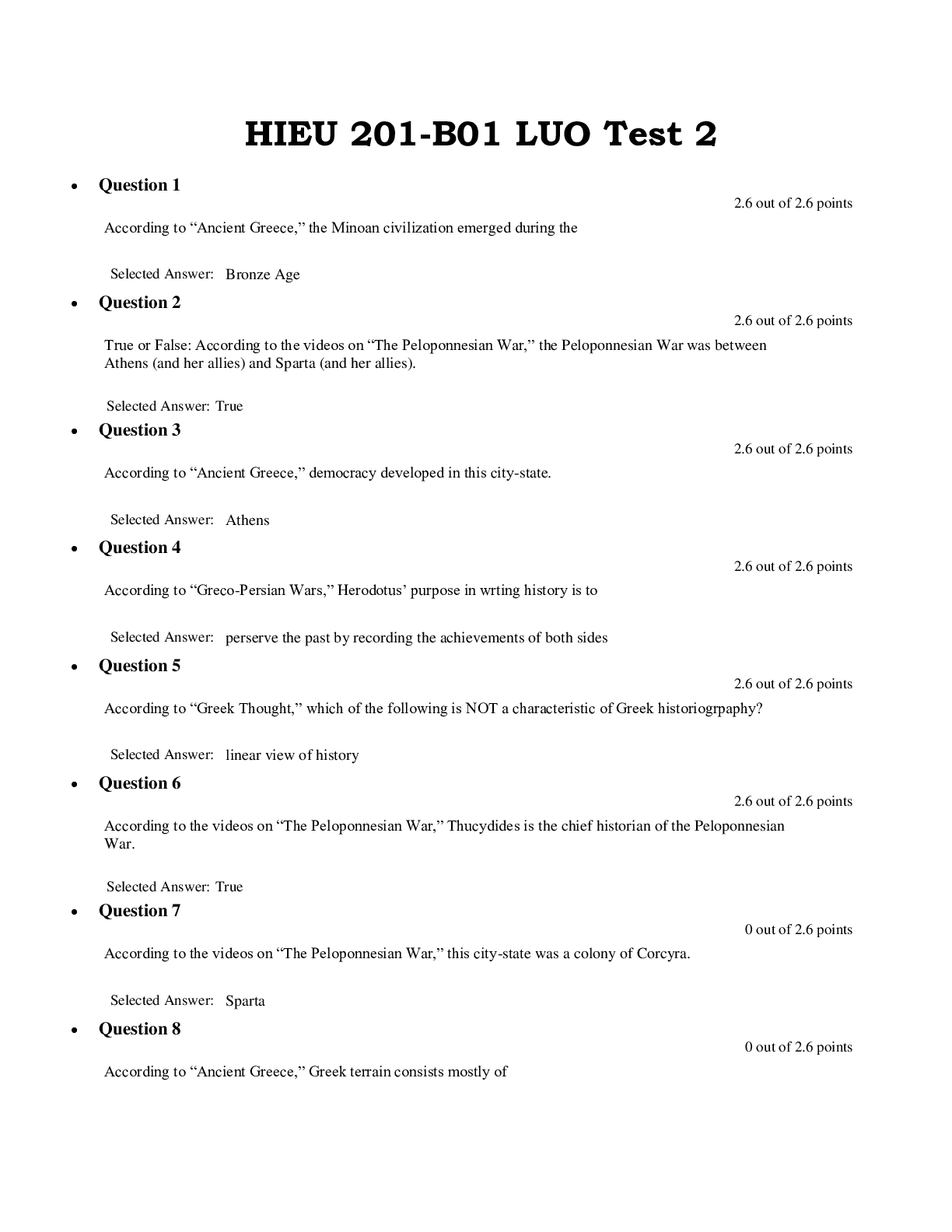
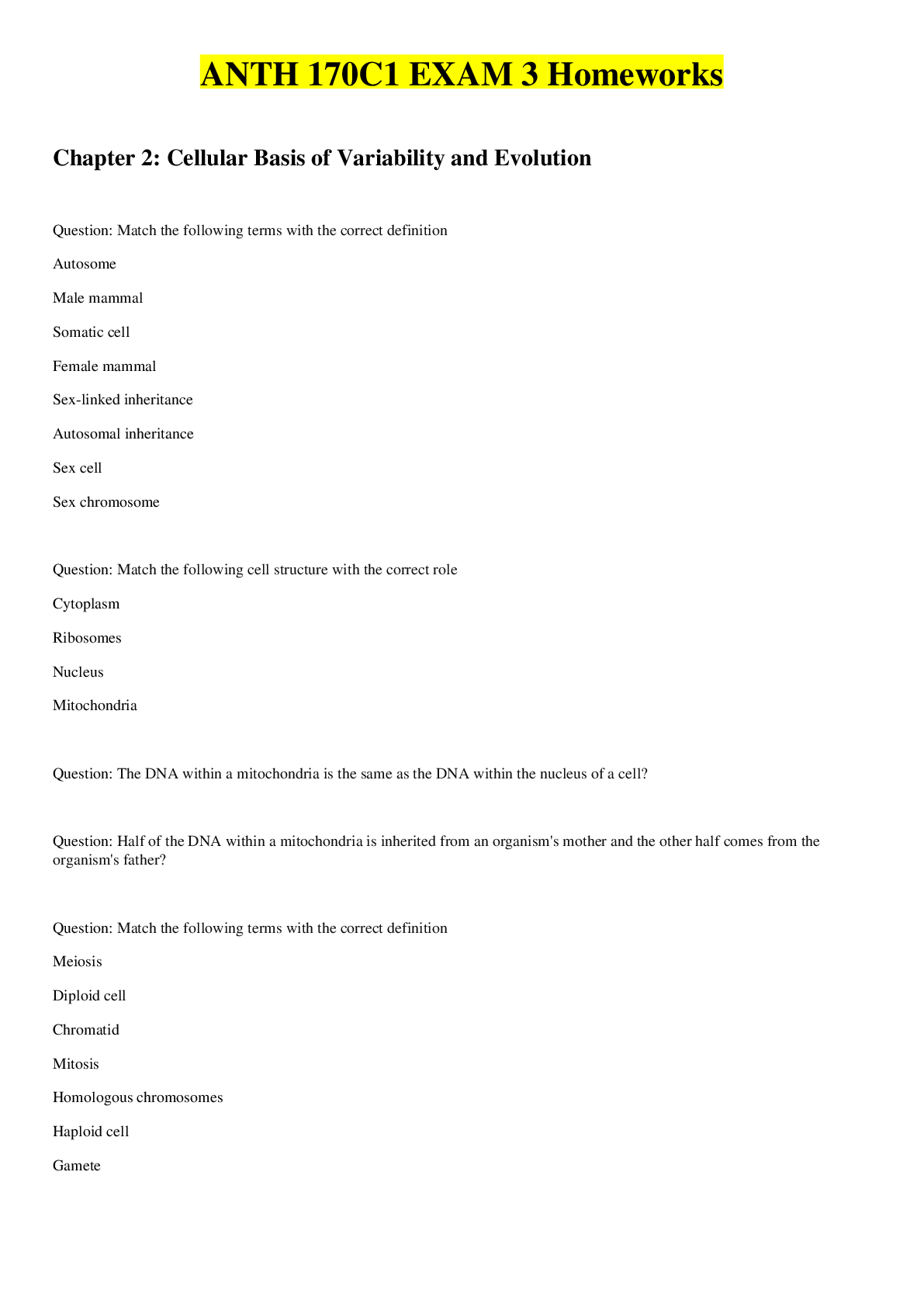

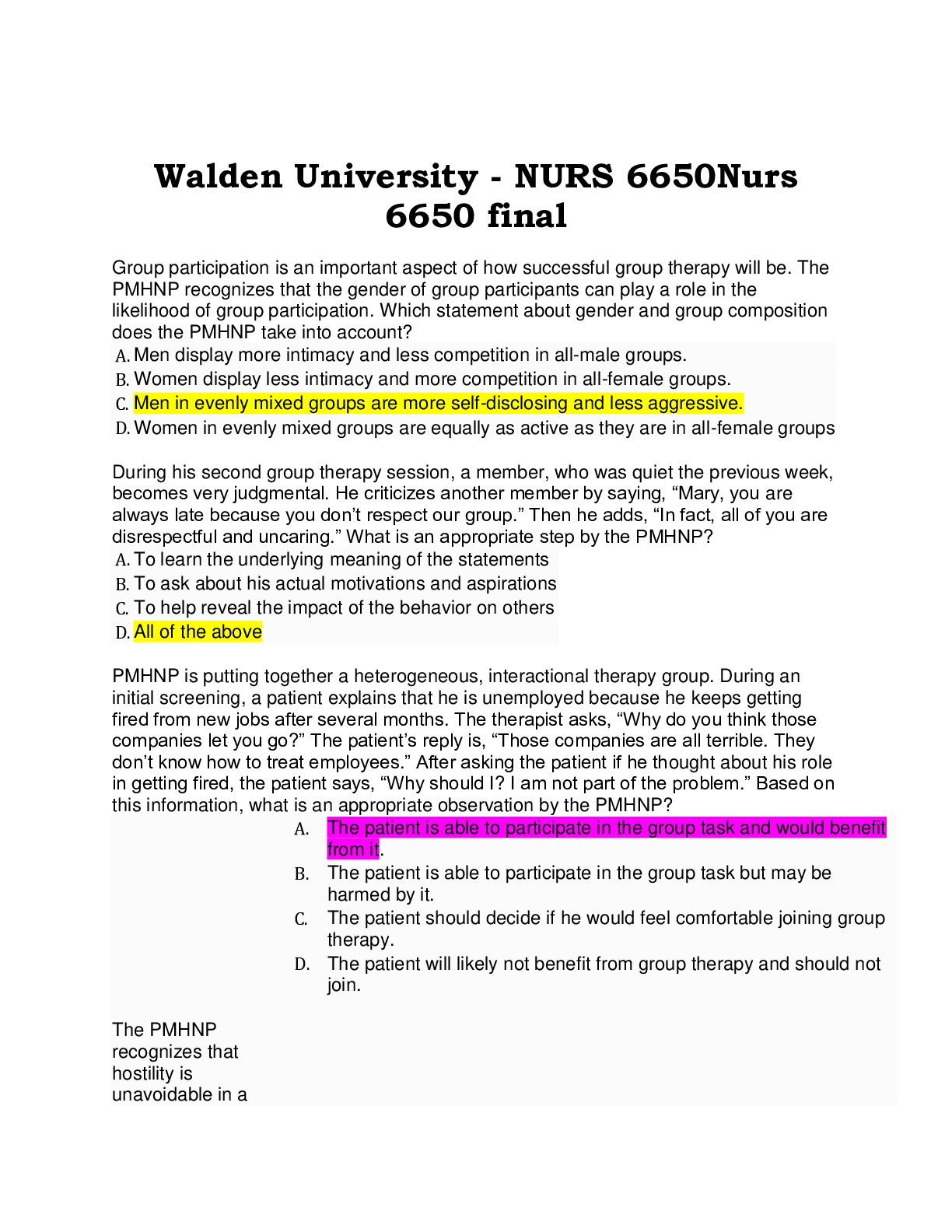
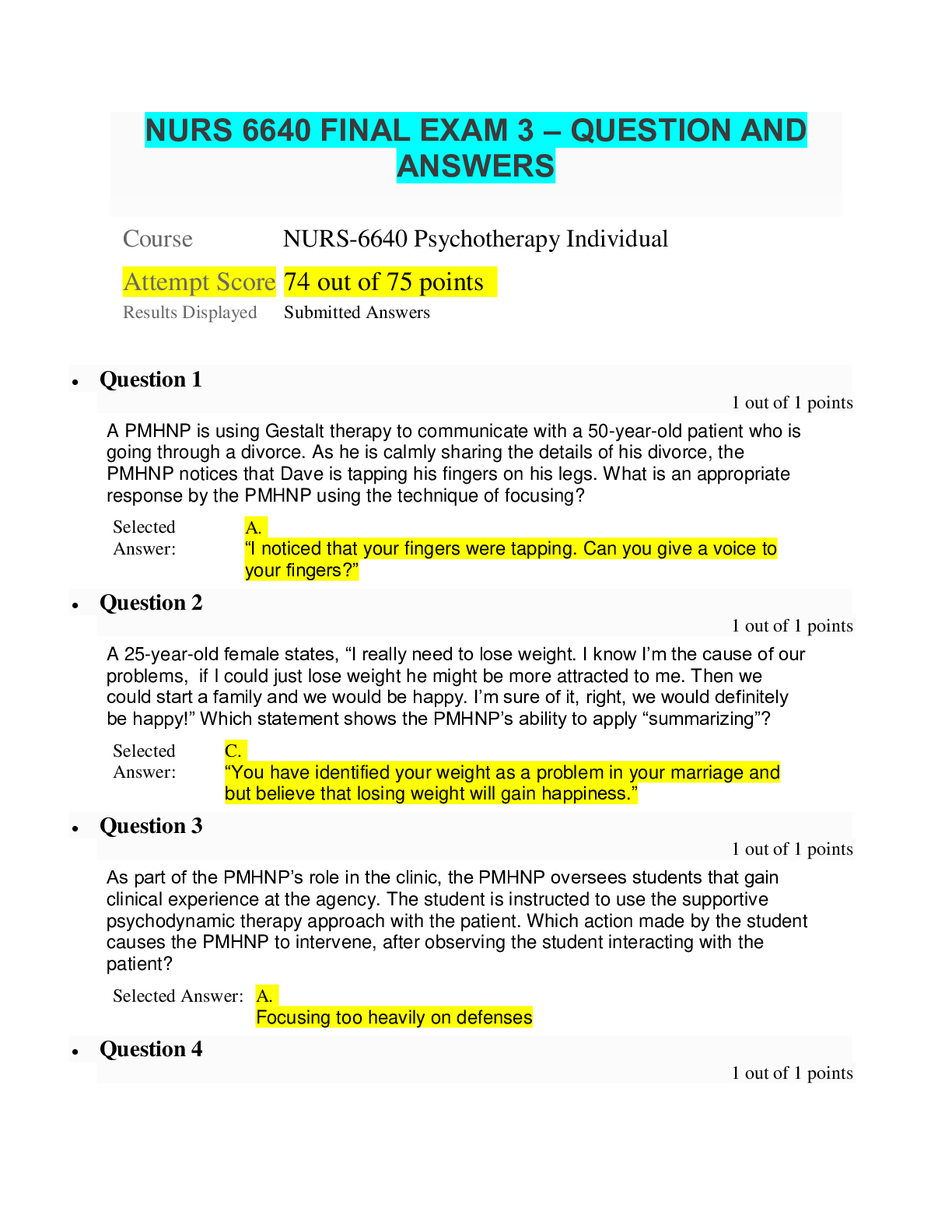
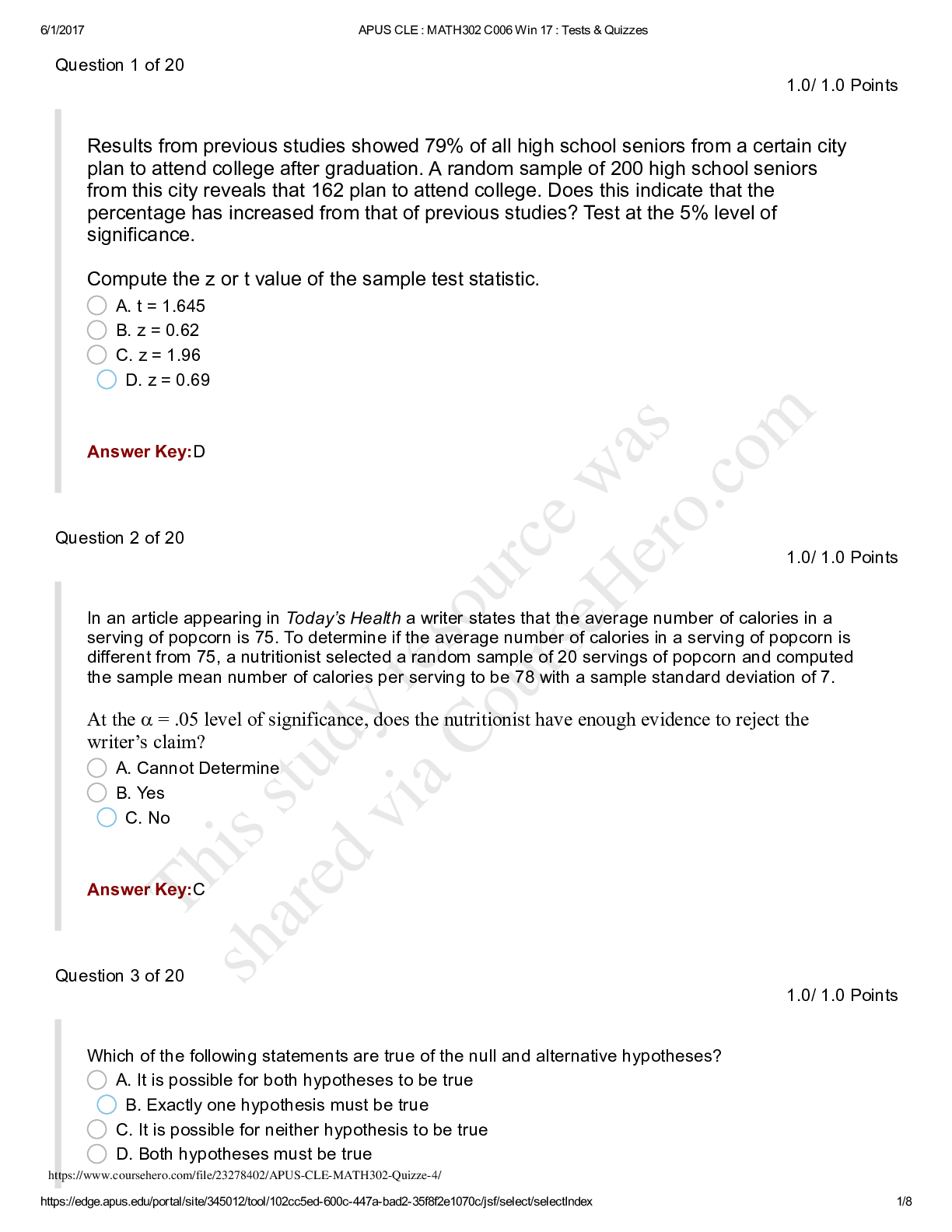


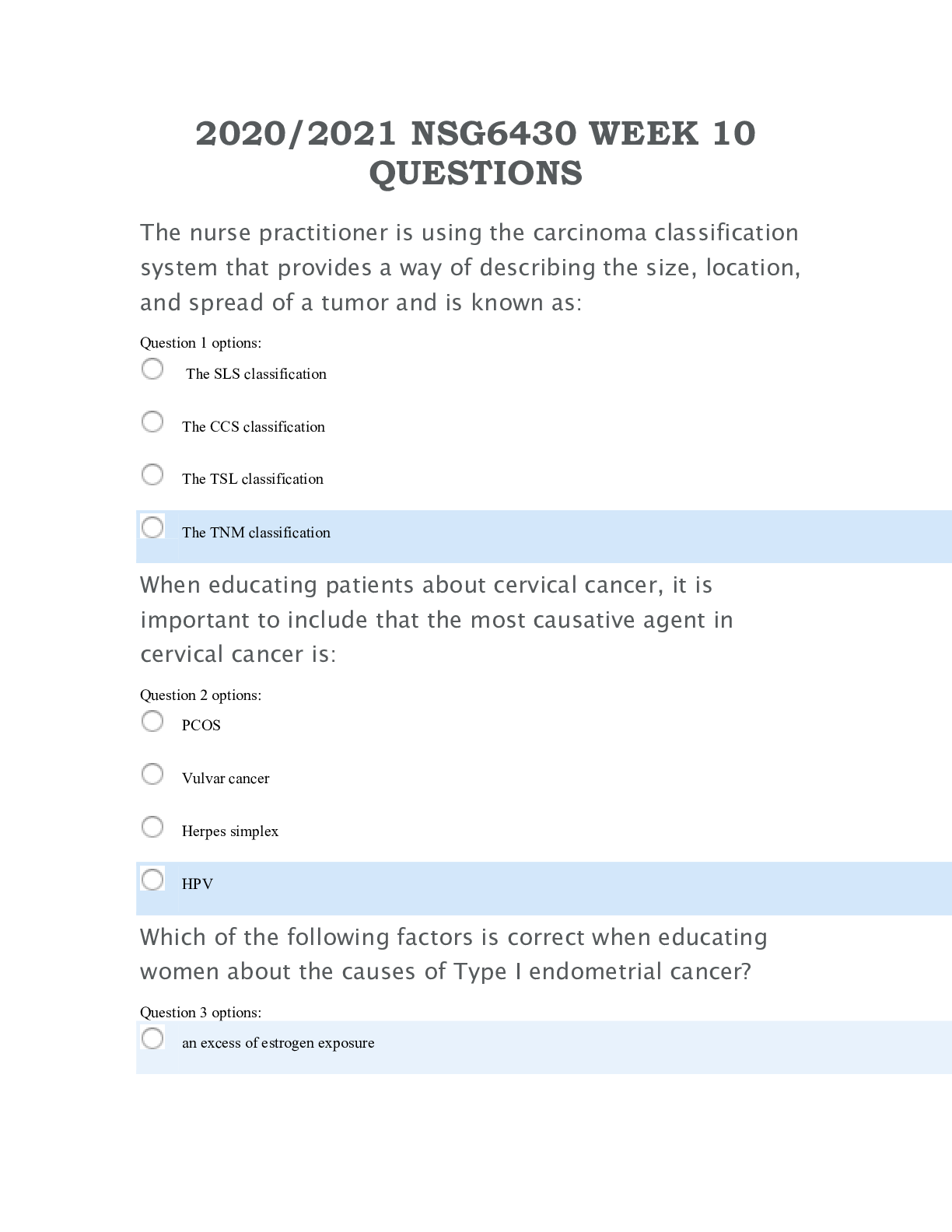
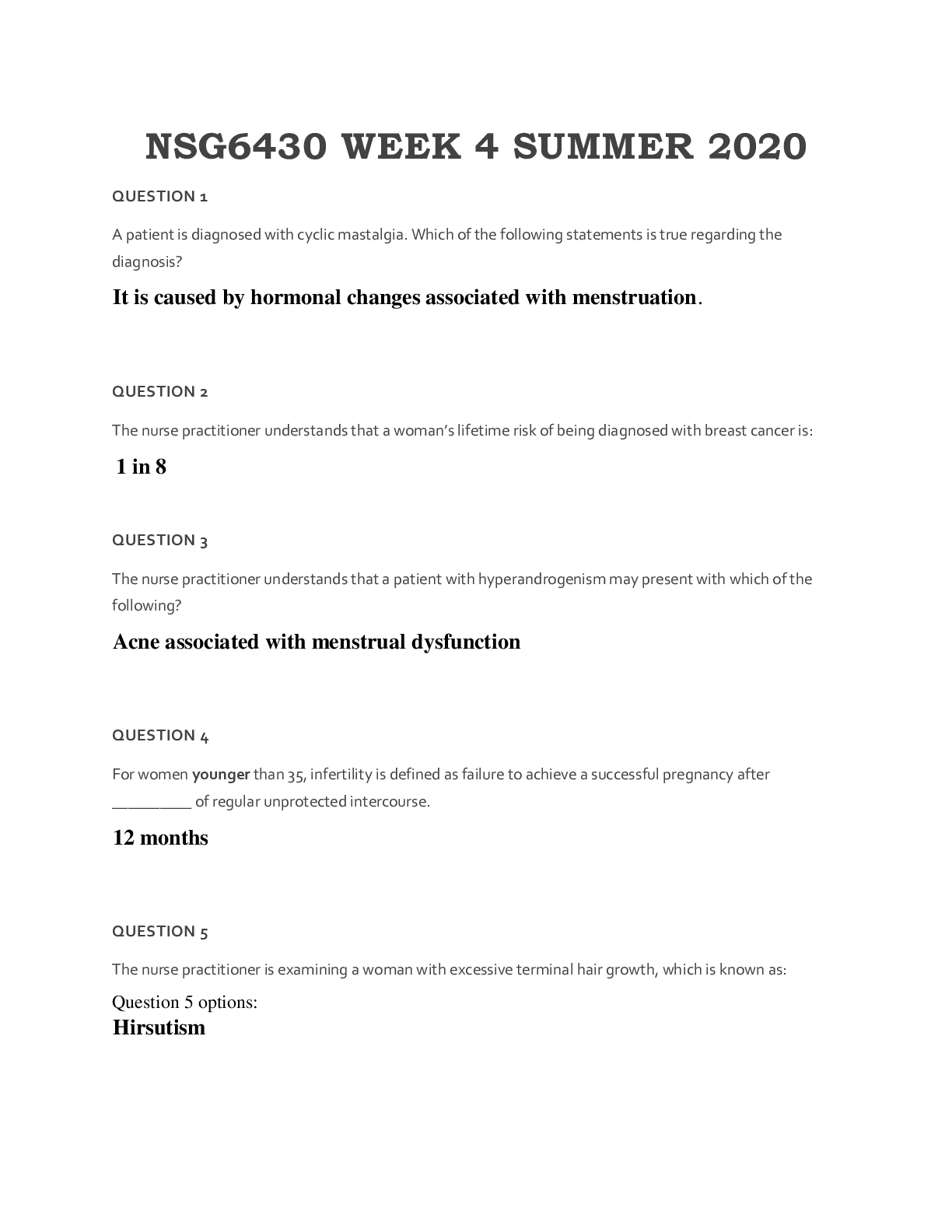


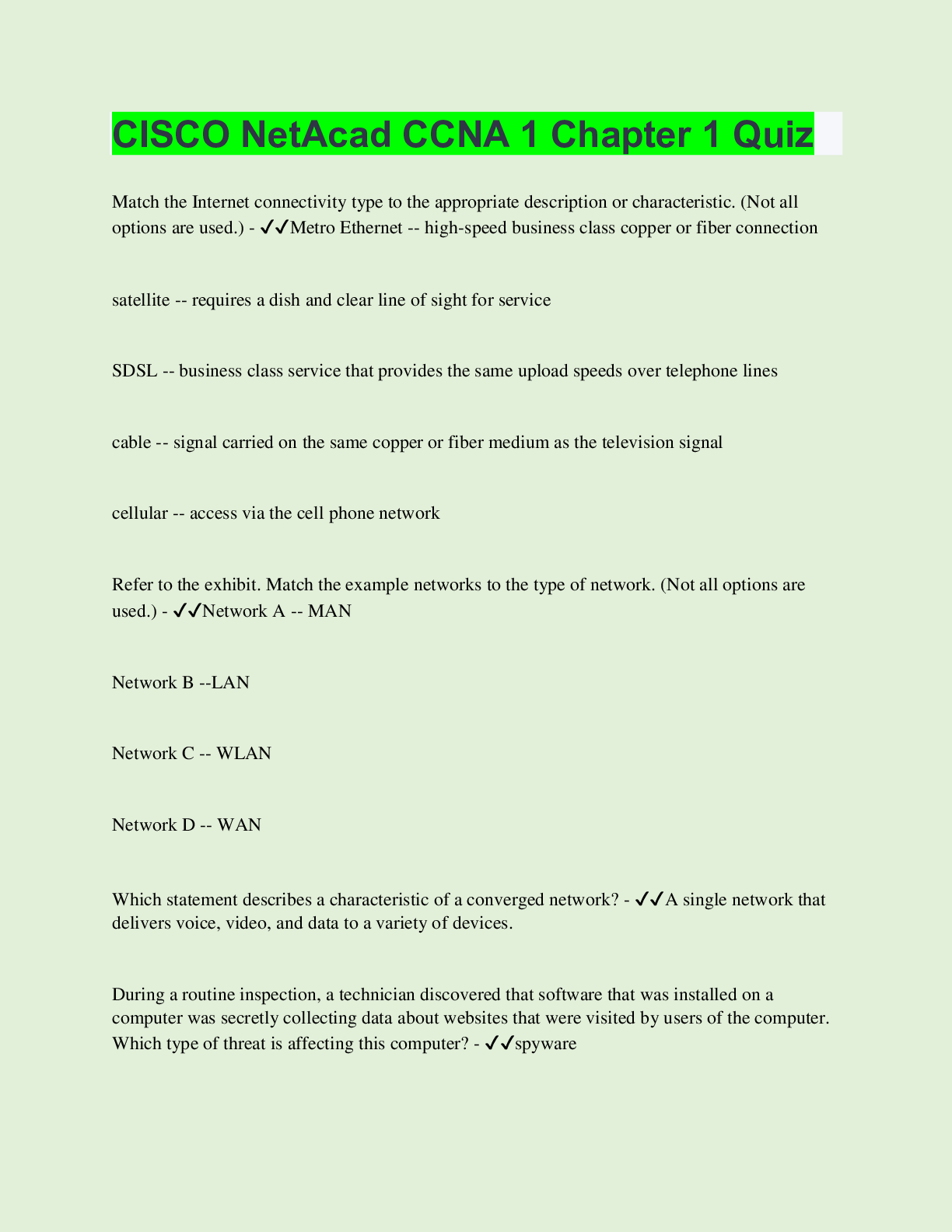
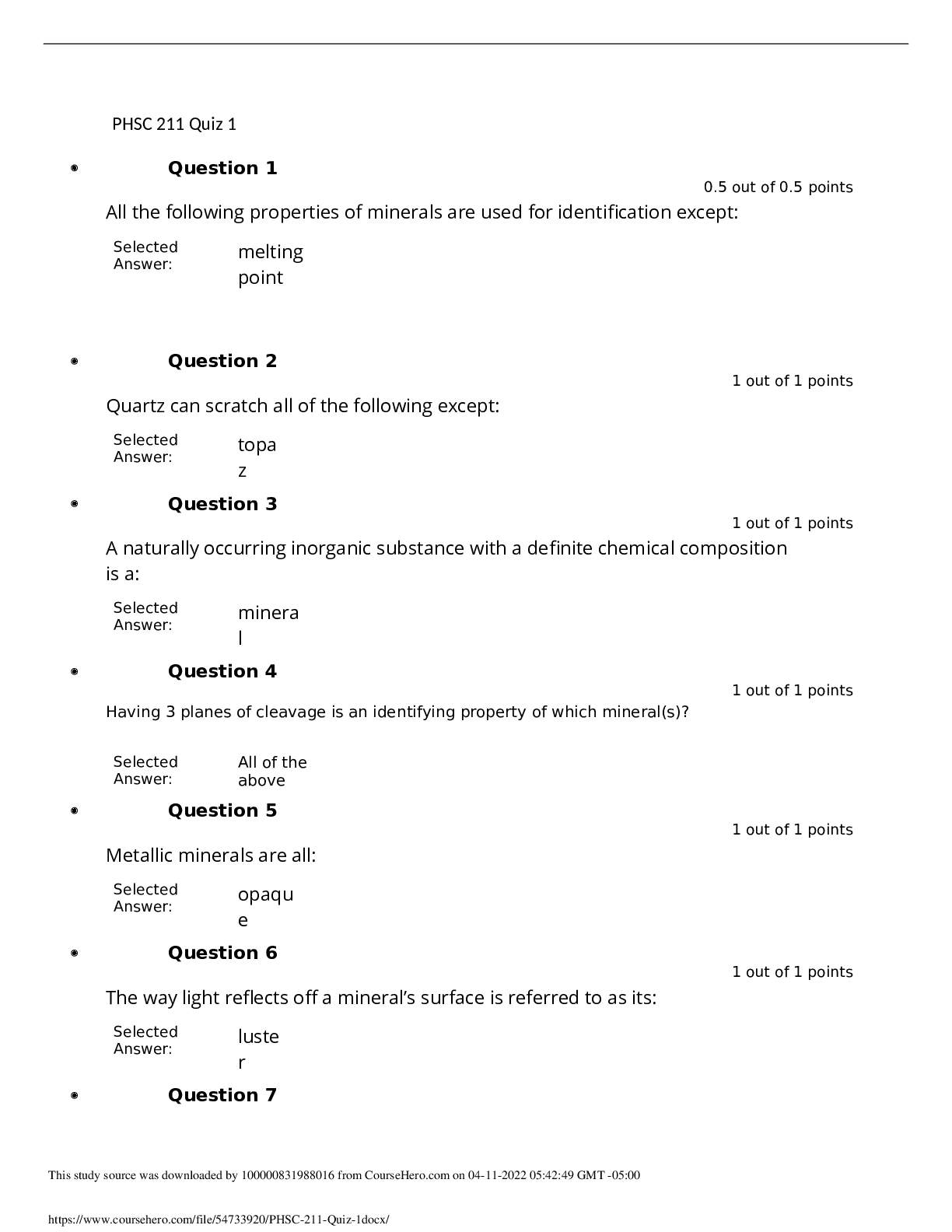
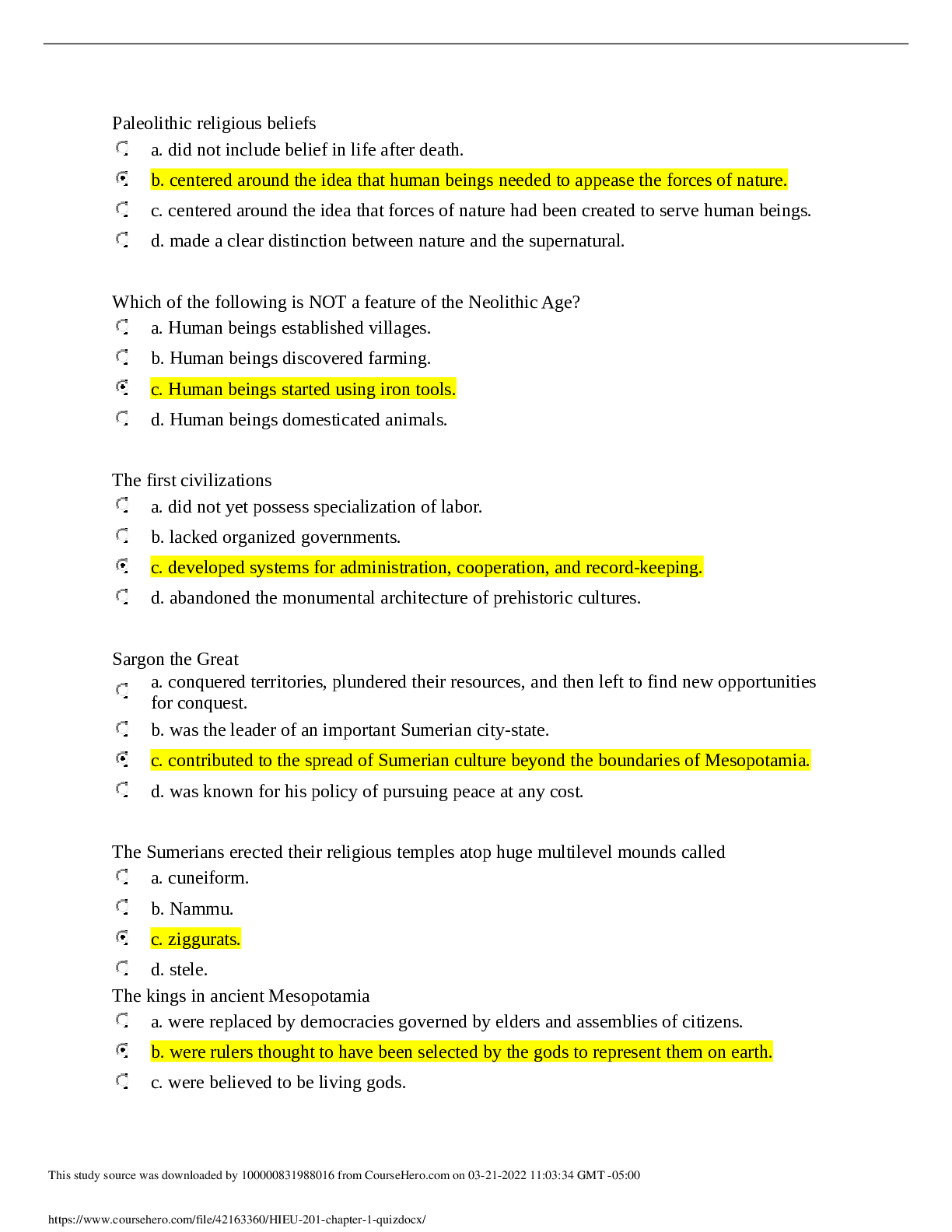
.png)
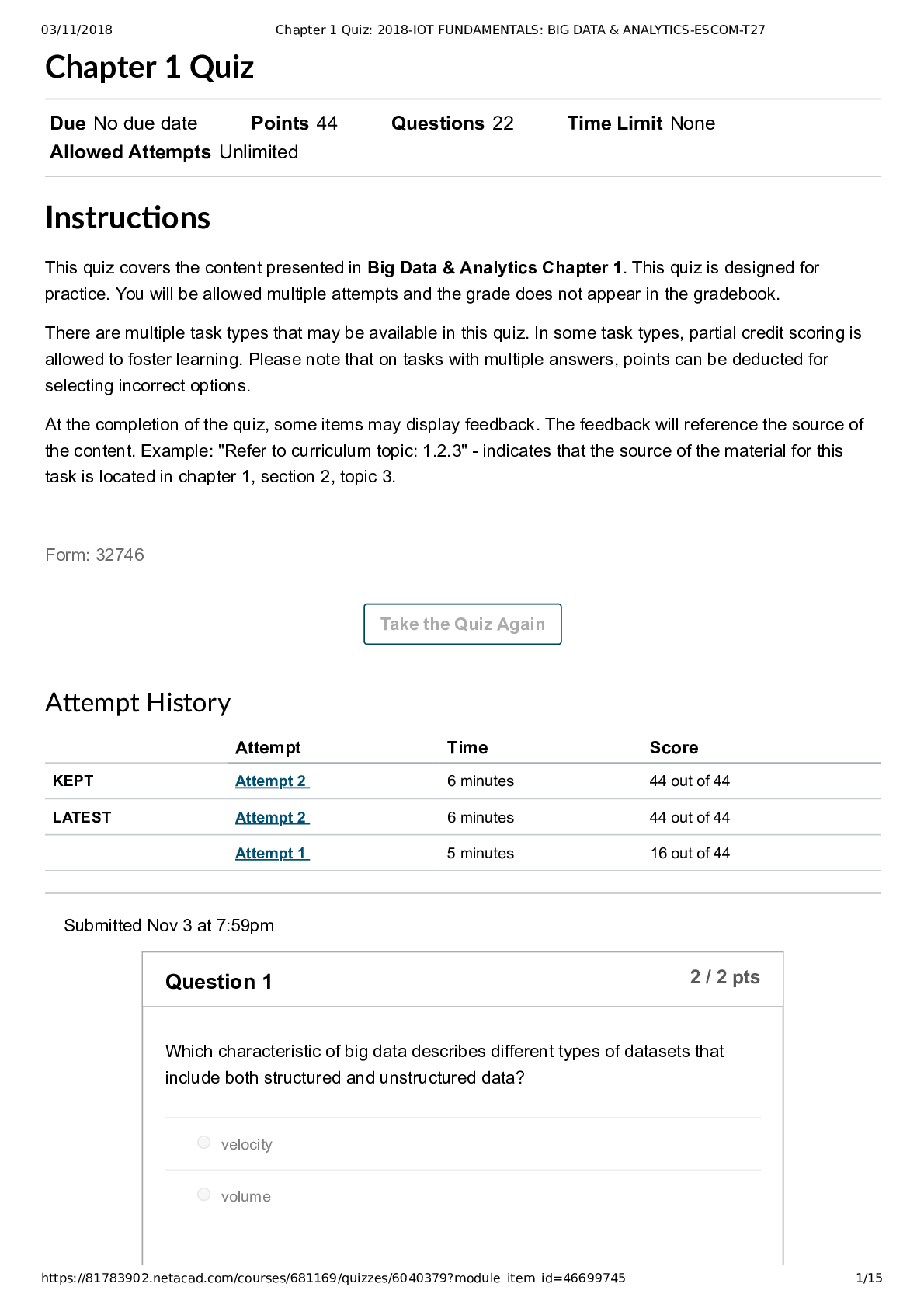

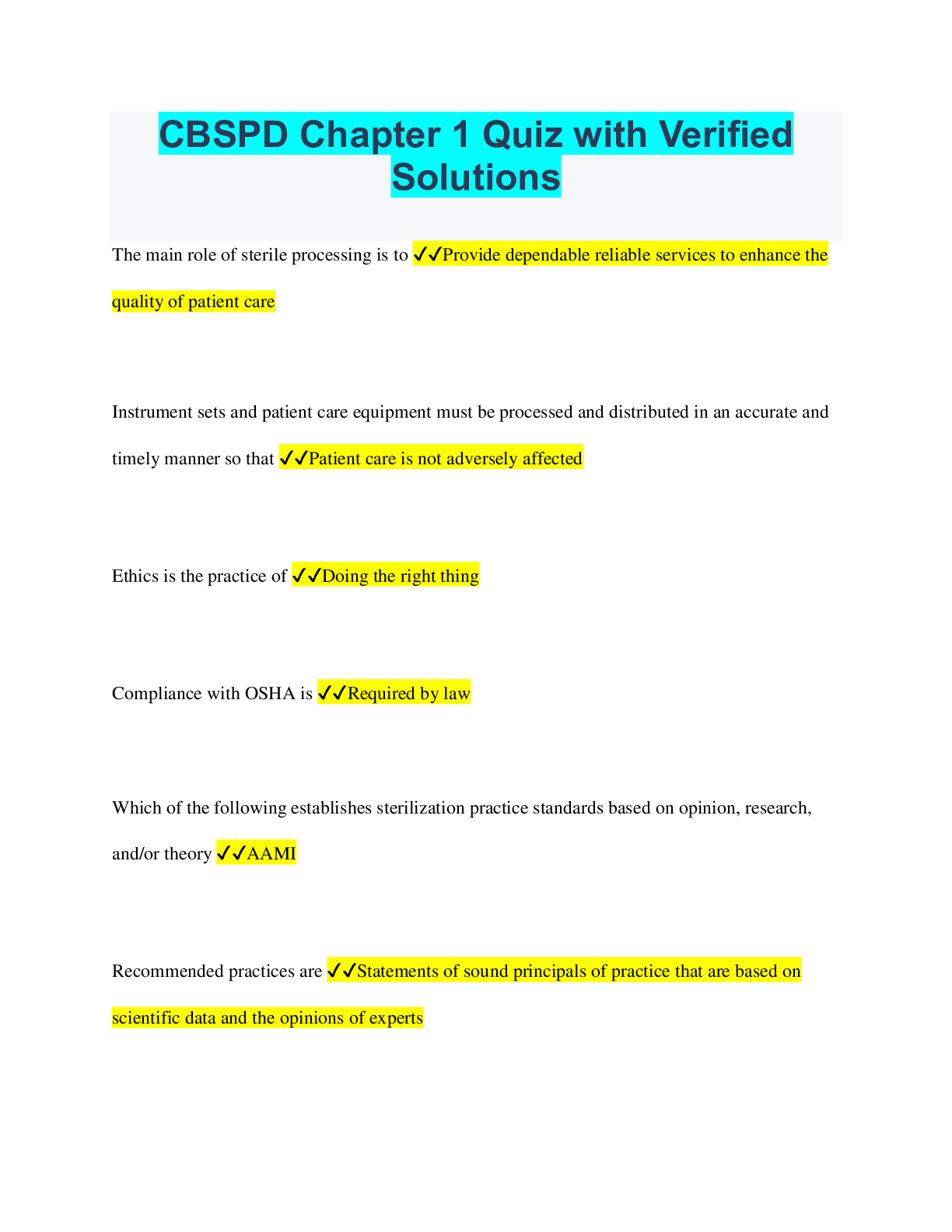



.png)

.png)




